Brazil Food Sweetener Market Size
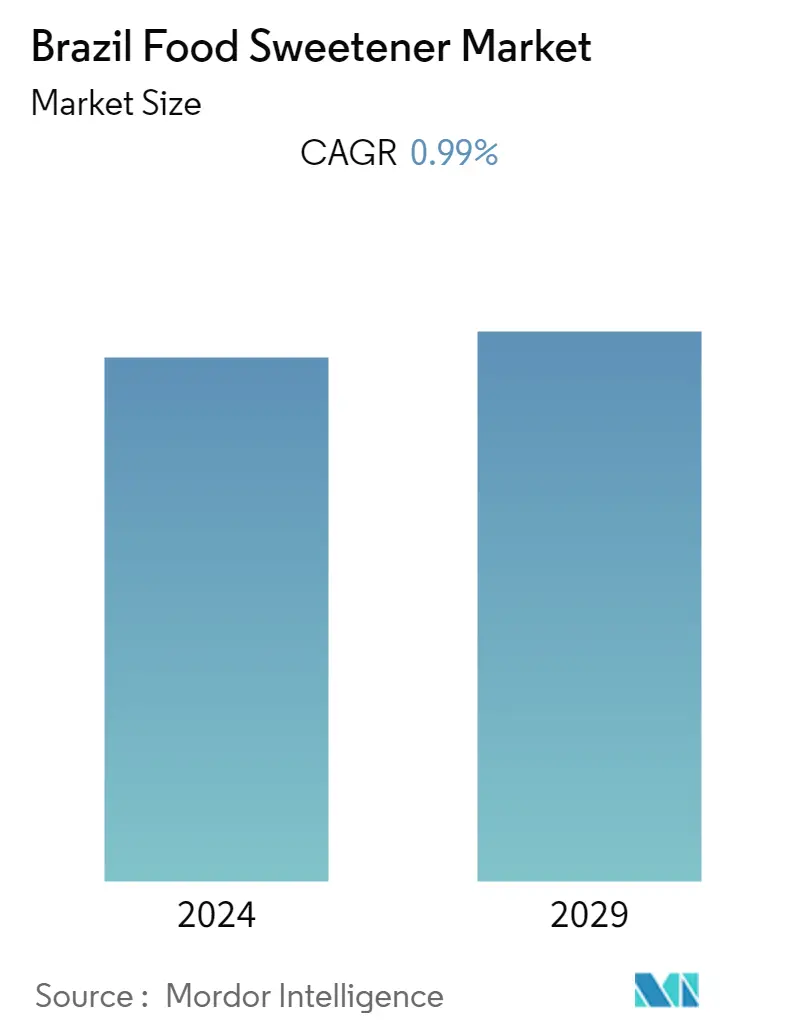
| Study Period | 2019 - 2029 |
| Base Year For Estimation | 2023 |
| Forecast Data Period | 2024 - 2029 |
| Historical Data Period | 2019 - 2022 |
| CAGR | 0.99 % |
| Market Concentration | Low |
Major Players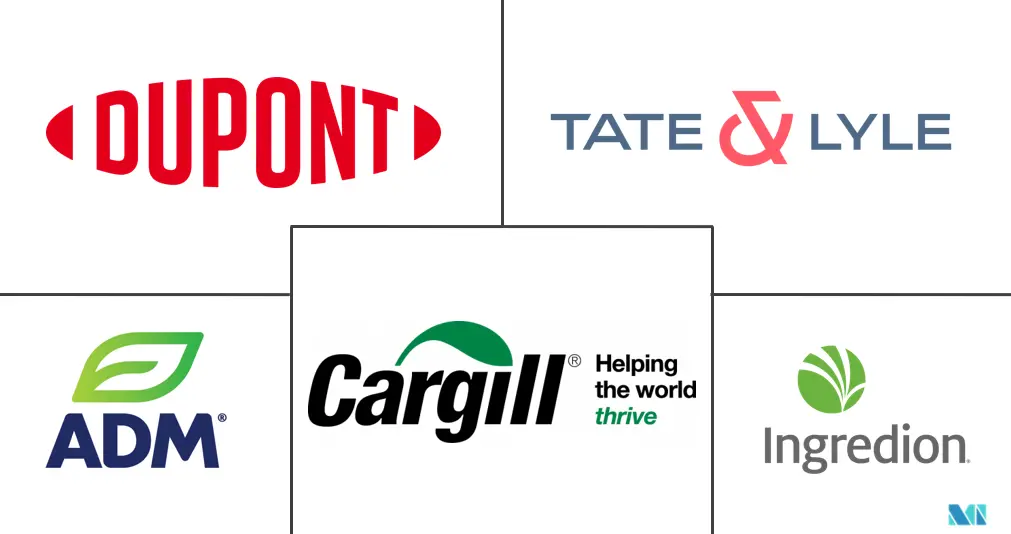
*Disclaimer: Major Players sorted in no particular order |
Brazil Food Sweetener Market Analysis
Brazil's Food Sweetener Market is projected to grow at a CAGR of 0.99% over the forecast period.
Brazil is the world's largest producer and exporter of sugar. A high level of sweetener consumption, coupled with the emerging economic status of the country, makes it an attractive market destination. The changing consumer preference drives the demand for healthier and safer food products with high nutritional value. The increased consumption of sugar alternatives in the industry contributes to the increased demand for sweeteners such as tapioca among food and drink manufacturers. Tapioca syrup is nutrition-rich, gluten-free, and free of contaminants and genetically engineered components.
Brazil's stevia growth is due to increased awareness and usage of dietary foods. Another primary driver is the growing population of overweight, obese, and diabetic patients, causing growth in this category. The inclination toward low-calorie beverages, such as diet coke and low-calorie drinks, and low-calorie foods, such as yogurt, ice cream, and grain-based desserts, has gained popularity in Brazil. Also, with the changing regulatory environment and permission for using sweeteners in dairy products, biscuits, and confectionery, the artificial sweeteners segment is witnessing high growth.
Brazil Food Sweetener Market Trends
Increasing Inclination Towards Organic /Natural Syrups
Consumers have begun to place more value on food that offers them functional benefits apart from taste, thereby, increasing the demand for healthy, natural, and organic syrup and sweeteners. These organic food alternatives are positively impacting Brazil's food sweetener market growth. The rates of obesity and type 2 diabetes are high in Brazil leading the government to take action to restrict sugar intake, and stevia is considered the 'number one priority ingredient'. With the increasing prevalence of diabetes across the region, consumers prefer to consume natural syrup with low-calorie sweeteners, increasing the market growth.
Owing to the high plea for natural and organic food products, food processing companies are incorporating natural food ingredients in their products. In Brazil, stevia is used extensively by food industries as it can be used in low dosages in beverages, hard candies, and cereals. For instance, Tate & Lyle, a global key player in the sweetener market collaborating with Sweet Green Fields has launched Label-friendly, 'natural flavor' glycosylated stevia extract in Brazil. The product is cheaper and blends easily with other ingredients.
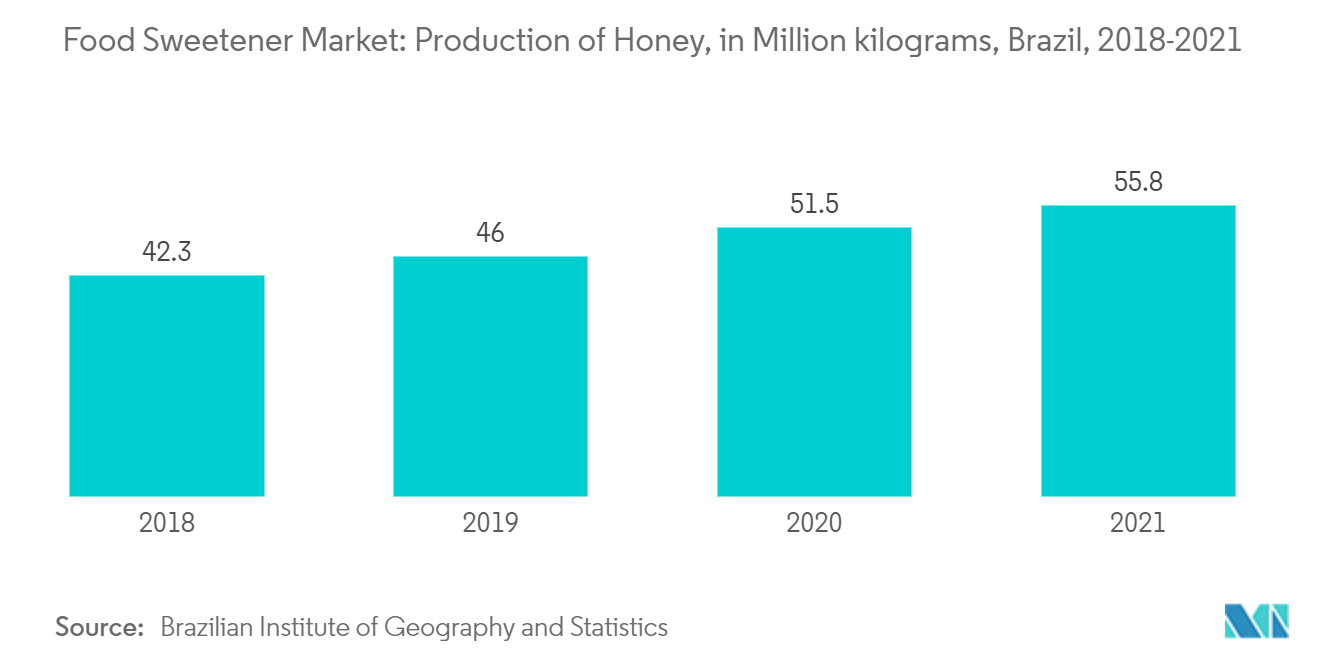
Beverage Segment Holds a Prominent Share in The Market
Consumers of Brazil desire diet beverages which are leading to the growth of the market studied. Diet-carbonated soft drinks incorporating sugar substitutes are majorly consumed in Brazil. According to the Brazilian Association of Soft Drinks and Non-Alcoholic Beverage Industries, the average consumed amount of soft drinks in the country was approximately 59.5 liters per person in 2021. In Brazil, the manufacturers of non-alcoholic beverages like nectars, juices, energy drinks, carbonated soft drinks, and sports drinks are replacing sugar with a low or no-calorie sugar substitute, claiming 'low in sugars' or 'reduced in sugars' to the front label of their products. The prohibition to use an amalgamation of sugar with low or no-calorie sweeteners to make reduced-calorie beverages has constrained the sweetener market in Brazil however, this decree has provided the ingredient producers to come up with new ingredients tools that can feed the trending demands of health-conscious consumers. Thus an increase in the number of beverage industries is driving the sweetener market in Brazil.
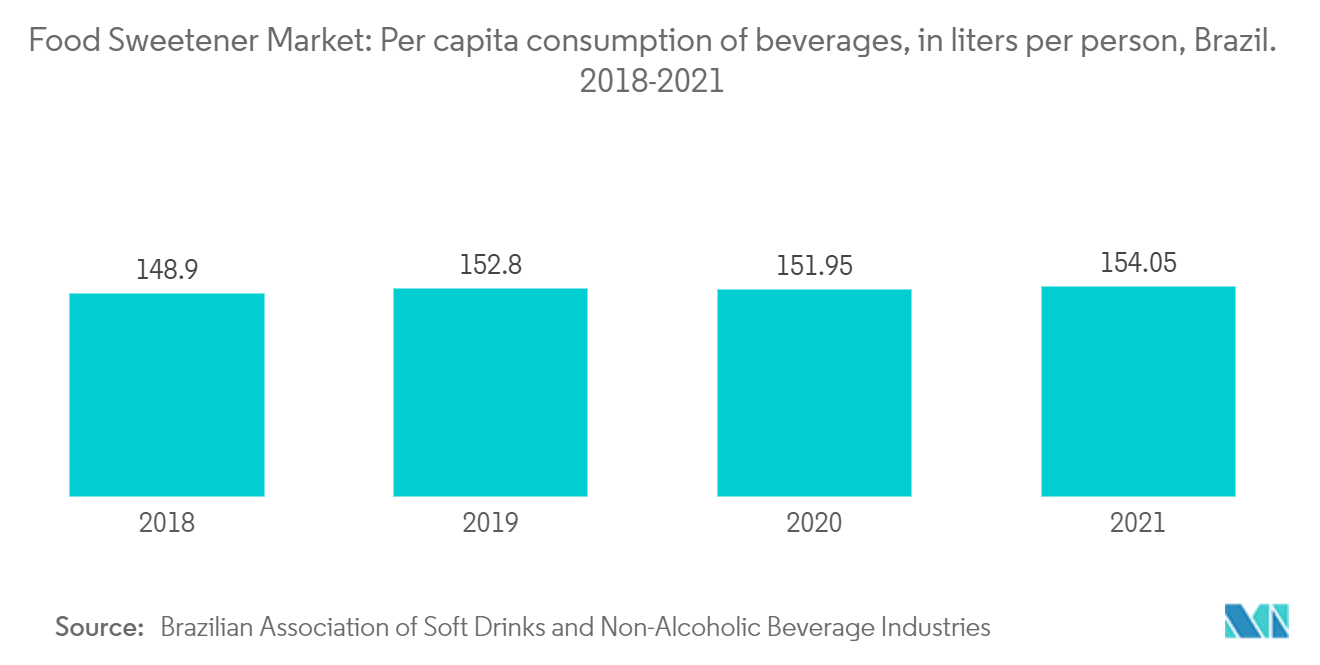
Brazil Food Sweetener Industry Overview
Brazil's food sweetener market is fragmented with several active players in this industry such as Tate & Lyle PLC, Cargill, Incorporated, Archer Daniels Midland Company, Ingredion Incorporated, and DuPont de Nemours Inc. among others. The leading companies are focused on launching innovative, low-calorie, and natural ingredient-based products. Emphasis is given to the companies' merger, expansion, acquisition, partnership, and new product development as strategic approaches adopted by the leading companies to boost their brand presence among consumers.
Brazil Food Sweetener Market Leaders
-
Tate & Lyle PLC
-
Cargill, Incorporated
-
Archer Daniels Midland Company
-
Ingredion Incorporated
-
DuPont de Nemours Inc.
*Disclaimer: Major Players sorted in no particular order
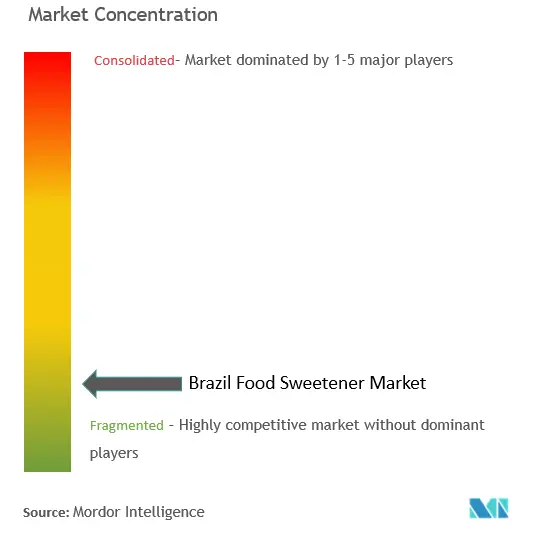
Brazil Food Sweetener Market News
- In January 2022, Amyris Inc. invested USD 80 million to build another plant in Brazil as the Emeryville-based company's ingredients business surged. The synthetic biology company, Amyris, turns fermented sugarcane into molecules used in skincare, haircare, cosmetics, fragrances, and sweeteners.
- In February 2021, Tate & Lyle PLC launched Tate & Lyle Nutrition Center in Brazil and worldwide. This new digital innovation and research center was formed to increase awareness regarding low- and no-calorie sweetener ingredients like fructose. The Nutrition Centre was developed by Tate & Lyle's global nutrition team which drives the company's science research program and supports food and beverage companies from its bases in the United Kingdom, United States, Brazil, and Singapore.
- In December 2020, Sugar reduction solutions company SweeGen announced Brazil's National Health and Surveillance Agency (ANVISA) has assessed and approved the company's full range of Bestevia stevia sweeteners as a food additive. This exclusive taste and sweetener platform offer sugar reduction solutions for applications across the spectrum, including beverages, dairy, confectionery, bakery, and sauces.
Brazil Food Sweetener Market Report - Table of Contents
1. INTRODUCTION
- 1.1 Study Assumptions and Market Definition
- 1.2 Scope of the Study
2. RESEARCH METHODOLOGY
3. EXECUTIVE SUMMARY
4. MARKET DYNAMICS
- 4.1 Market Drivers
- 4.2 Market Restraints
-
4.3 Porter's Five Forces Analysis
- 4.3.1 Threat of New Entrants
- 4.3.2 Bargaining Power of Buyers/Consumers
- 4.3.3 Bargaining Power of Suppliers
- 4.3.4 Threat of Substitute Products
- 4.3.5 Intensity of Competitive Rivalry
5. MARKET SEGMENTATION
-
5.1 Product Type
- 5.1.1 Sucrose
- 5.1.2 Starch Sweeteners and Sugar Alcohols
- 5.1.2.1 Dextrose
- 5.1.2.2 High Fructose Corn Syrup
- 5.1.2.3 Maltodextrin
- 5.1.2.4 Sorbitol
- 5.1.2.5 Xylitol
- 5.1.2.6 Others
- 5.1.3 High Intensity Sweeteners
- 5.1.3.1 Sucralose
- 5.1.3.2 Aspartame
- 5.1.3.3 Saccharin
- 5.1.3.4 Cyclamate
- 5.1.3.5 Ace-K
- 5.1.3.6 Neotame
- 5.1.3.7 Stevia
- 5.1.3.8 Others
-
5.2 Application
- 5.2.1 Bakery and Confectionery
- 5.2.2 Dairy and Desserts
- 5.2.3 Beverages
- 5.2.4 Meat and Meat Products
- 5.2.5 Soups, Sauces, and Dressings
- 5.2.6 Other Applications
6. COMPETITIVE LANDSCAPE
- 6.1 Most Adopted Strategies
- 6.2 Market Share Analysis
-
6.3 Company Profiles
- 6.3.1 Ingredion Incorporated
- 6.3.2 DuPont de Nemours Inc.
- 6.3.3 Cargill, Incorporated
- 6.3.4 Tate & Lyle PLC
- 6.3.5 Archer Daniels Midland Company
- 6.3.6 BASF SA
- 6.3.7 Koninklijke DSM N.V.
- 6.3.8 Brenntag AG
- 6.3.9 Givaudan SA
- 6.3.10 Kerry Group plc
- *List Not Exhaustive
7. MARKET OPPORTUNITIES AND FUTURE TRENDS
** Subject To AvailablityBrazil Food Sweetener Industry Segmentation
Sweeteners are the various natural and artificial substances that impart a sweet taste to foods and beverages. Brazil's food sweetener market is segmented by type and application. Based on the type, the market is segmented into sucrose, starch sweeteners and sugar alcohols, and high-intensity sweeteners (HIS). Starch sweeteners and sugar alcohols are further sub-segmented into dextrose, high fructose corn syrup (HFCS), maltodextrin, sorbitol, and other starch sweeteners and sugar alcohols. The high-intensity sweeteners (HIS) are further sub-segmented into sucralose, aspartame, saccharin, neotame, stevia, cyclamate, acesulfame potassium (Ace-K), and other applications. Based on the application, the market is segmented into bakery and confectionery, dairy and desserts, meat and meat products, soups, sauces and dressings, and other applications. For each segment, market sizing and forecast have been done based on value (USD million).
| Product Type | Sucrose | |
| Starch Sweeteners and Sugar Alcohols | Dextrose | |
| High Fructose Corn Syrup | ||
| Maltodextrin | ||
| Sorbitol | ||
| Xylitol | ||
| Others | ||
| High Intensity Sweeteners | Sucralose | |
| Aspartame | ||
| Saccharin | ||
| Cyclamate | ||
| Ace-K | ||
| Neotame | ||
| Stevia | ||
| Others | ||
| Application | Bakery and Confectionery | |
| Dairy and Desserts | ||
| Beverages | ||
| Meat and Meat Products | ||
| Soups, Sauces, and Dressings | ||
| Other Applications |
Brazil Food Sweetener Market Research FAQs
What is the current Brazil Food Sweetener Market size?
The Brazil Food Sweetener Market is projected to register a CAGR of 0.99% during the forecast period (2024-2029)
Who are the key players in Brazil Food Sweetener Market?
Tate & Lyle PLC, Cargill, Incorporated, Archer Daniels Midland Company, Ingredion Incorporated and DuPont de Nemours Inc. are the major companies operating in the Brazil Food Sweetener Market.
What years does this Brazil Food Sweetener Market cover?
The report covers the Brazil Food Sweetener Market historical market size for years: 2019, 2020, 2021, 2022 and 2023. The report also forecasts the Brazil Food Sweetener Market size for years: 2024, 2025, 2026, 2027, 2028 and 2029.
Brazil Food Sweetener Industry Report
Statistics for the 2024 Brazil Food Sweetener market share, size and revenue growth rate, created by Mordor Intelligence™ Industry Reports. Brazil Food Sweetener analysis includes a market forecast outlook 2029 and historical overview. Get a sample of this industry analysis as a free report PDF download.



